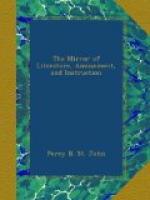“The signal for starting was made, and the impatient animals sprung forward and set off at a full gallop. The riders brandished their spears, the little boys flourished their cows’ tails, the buffoons performed their antics, muskets were discharged, and the chief himself, mounted on the finest horse on the ground, watched the progress of the race, while tears of delight were starting from his eyes. The sun shone gloriously on the tobes of green, white, yellow, blue, and crimson, as they fluttered in the breeze; and with the fanciful caps, the glittering spears, the jingling of the horses’ bells, the animated looks and warlike bearing of their riders, presented one of the most extraordinary and pleasing sights that we have ever witnessed. The race was well contested, and terminated only by the horses being fatigued and out of breath; but though every one was emulous to outstrip his companion, honour and fame were the only reward of the competitors.
“A few naked boys, on ponies without saddles, then rode over the course, after which the second and last heat commenced. This was not by any means so good as the first, owing to the greater anxiety which the horsemen evinced to display their skill in the use of the spear and the management of their animals. The king maintained his seat on horseback during these amusements, without even once dismounting to converse with his wives and children who were sitting on the ground on each side of him. His dress was showy rather than rich, consisting of a red cap, enveloped in the large folds of a white muslin turban; two under tobes of blue and scarlet cloth, and an outer one of white muslin; red trousers, and boots of scarlet and yellow leather. His horse seemed distressed by the weight of his rider, and the various ornaments and trappings with which his head, breast, and body, were bedecked. The chief’s eldest and youngest sons were near his women and other children, mounted on two noble looking horses. The eldest of these youths was about eleven years of age. The youngest being not more than three, was held on the back of his animal by a male attendant, as he was unable to sit upright in the saddle without this assistance. The child’s dress was ill suited to his age. He wore on his head a tight cap of Manchester cotton, but it overhung the upper part of his face, and together with its ends, which flapped over each cheek, hid nearly the whole of his countenance from view; his tobe and trousers were made exactly in the same fashion as those of a man, and two large belts of blue cotton, which crossed each other, confined the tobe to his body. The little legs of the child were swallowed up in clumsy yellow boots, big enough for his father; and though he was rather pretty, his whimsical dress gave him altogether so odd an appearance, that he might have been taken for anything but what he really was. A few of the women on the ground by the side of the king wore large white dresses, which covered their




